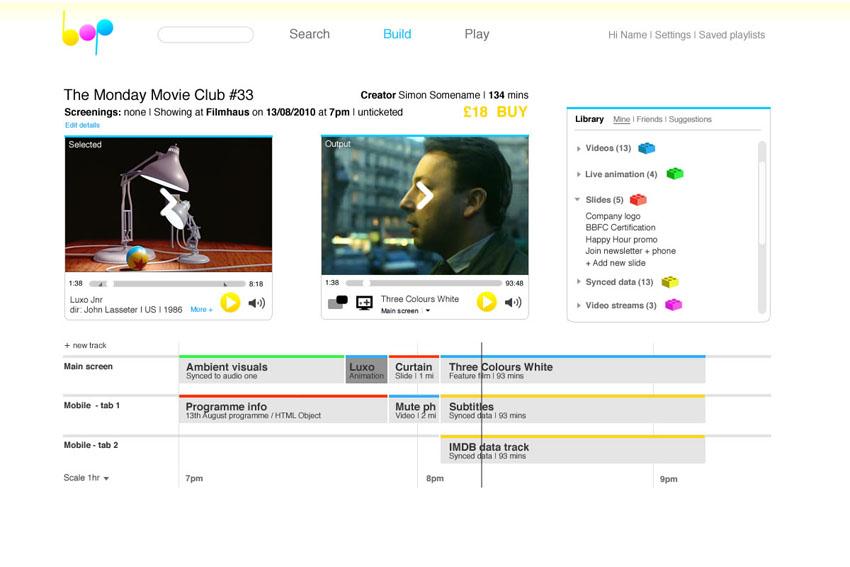Cinema-on-demand: the Big Open Playlister

This project was motivated by the struggle producers and distributors have to make a return on their work. With online revenues for films still uncertain, exhibition income is more important than ever, as it remains one market where people are happy to pay for content - and the market is healthy and growing. The music industry has weathered many of the challenges of the digital transition thru a resurgence in festivals, touring and concerts, which overtook sales of singles and albums in 2009, as the biggest earner.
However, despite developments such as the Digital Screen Network - which requires cinemas to programme a non-mainstream content on some screens in return for capital grants - exhibition is still very hard for independent filmmakers to access. Over the past three years Netribution has been exploring how changes to the way people are gathering to watch films can offer new opportunities for filmmakers to access the market; while the rise of social media and marketing could change the way people discover content in the first place.
Networked discovery: A new hope
Online there are three stand-out examples of the power of networks being used to mobilise people around film screenings outside of conventional cinemas with the help of websites:
- Iraq for Sale used the website BraveNewTheaters.com to organise 3000 screenings across the US on the opening weekend (having previously been the first feature film to crowd-source its budget). The site continues to be used to mobilise and promote screenings of independent documentaries for non-traditional public screenings. The producer and technical brains behind the project, Jim Gilliam, went on to set up Nation Builder.
- Four Eyed Monsters invited fans of their free online video-podcasts to request a screening in their local town. These were plotted on a Google map and when enough people in a region had requested a screening they would phone cinemas in that area to arrange a screening. Their screen averages far outstripped industry averages for that period, and the project led to the websites OpenIndie.com and CrowdControls.cc by the main team and which both support audience-powered screenings. Forthcoming Finnish indie film Iron Sky has used CrowdControls to net over 30,000 screening requests during production.
- Age of Stupid used another website - IndieScreeings.net - to sell custom licenses to screenings for schools, town halls, community groups and so forth, raising over £140,000 at the same time as a traditional cinema and DVD release thru Dogwoof.
Each of these online services have shown remarkable success in using the web and network effects to get interest in projects that might once have struggled to get a cinema release, let alone large-scale exposure, yet depend upon posting out DVDs to the person screening the film.
Cinema-on-demand.
 Most digital cinema works around the distribution of films thru either encrypted hard drives or satellite connections. However as fibre and superfast broadband becomes more widespread, it seems inevitable this will become the preferred method for delivering digital files. Indeed, as this project was coming to a close news emerged that a group of independent cinemas in the north of England had received BFI funding to build, test and trial delivery of films across a fibre network. The advantages are numerous:
Most digital cinema works around the distribution of films thru either encrypted hard drives or satellite connections. However as fibre and superfast broadband becomes more widespread, it seems inevitable this will become the preferred method for delivering digital files. Indeed, as this project was coming to a close news emerged that a group of independent cinemas in the north of England had received BFI funding to build, test and trial delivery of films across a fibre network. The advantages are numerous:
- Cheaper. The storage and bandwidth costs are normally less than hard-drive/DVD/Blu-Ray burning and postage.
- Quicker. Film programmes can be finalised just before a screening starts allowing more flexibility with programming.
- Monitoring. While it’s impossible to know how many times a disc, tape or film reel has been played, digital delivery can allow for tracking of films played - where, when, how often and for how long.
- Global campaigns. Although dependent on the rollout of broadband, it will be far easier for an independent producer or distributor to manage an international exhibition campaign if they don’t need to ship prints, tapes, discs or hard drives to remote locations.
- Efficiencies of scale. By removing the staff time of processing licenses and sending out copies of the film, more content can be made available without an increase in costs - i.e. it would be much easier to offer an archive of several thousand titles for distribution digitally than storing physical copies and manually processing each license.
- Innovation. Just as 3D has reinvigorated the exhibition sector, digitally delivered exhibition opens up strong potential for interactive cinema experiences and locally-specific content.
NB: this project worked (youtube search, library, drag and drop playlisting, syncing two screens, etc) — please get in touch if you would like to develop it further; the only reason it's not on Github/Gitalb under a FLOSS license is it's undocumented.